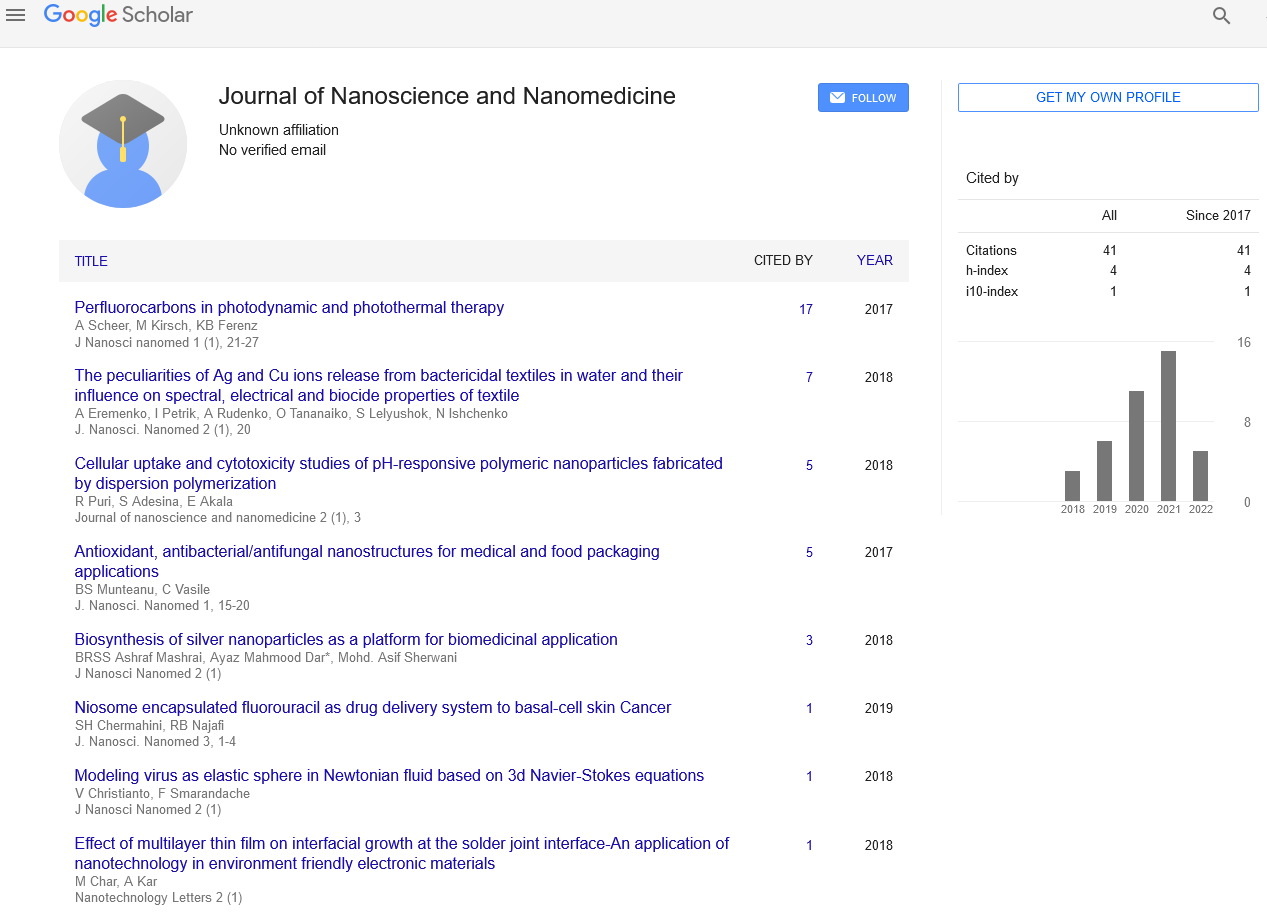Significant of Nanoparticles in Development of Free Radicals
Received: 07-Mar-2021 Accepted Date: Mar 19, 2021; Published: 25-Mar-2021
Citation: Dara P. Significant of Nanoparticles in Development of Free Radicals. J Nanosci Nanomed 2021;5(2):6.
This open-access article is distributed under the terms of the Creative Commons Attribution Non-Commercial License (CC BY-NC) (http://creativecommons.org/licenses/by-nc/4.0/), which permits reuse, distribution and reproduction of the article, provided that the original work is properly cited and the reuse is restricted to noncommercial purposes. For commercial reuse, contact reprints@pulsus.com
Nanoparticles that are taken up intracellular can instigate cell impacts whose natural importance stays to be explained. Exploratory examinations show that nanoparticles can trigger the creation of free extremists. The ongoing arrival of such responsive atoms can prompt tissue degeneration. The surface design of nanoparticles assumes a critical part in the association with cells and ought to thusly be viewed as while assessing their wellbeing impacts. The conversation regularly revolves around systems of activity including free extreme advancement after nanoparticle take-up into the cell [1].
Free extremists assume a significant part in oxygen-subordinate (high-impact) living frameworks. They are a significant segment in cell breath and other essential cell measures, but on the other hand are engaged with maturing and in illness improvement. Free extremists are flimsy particles with free external electrons (unpaired electrons). They are profoundly responsive on the grounds that the free electrons consistently endeavor to bond with different electrons and structure covalent sets. In this interaction the free extremists take the electrons from different particles [1]. This chain response is inescapable in each cell of the human body. Past influencing cell guideline, it can likewise harm particles like sugars, fats, proteins and nucleic acids.
Nonenzymatic cell reinforcements can likewise kill radicals4 (for example water-solvent substances like nutrient C, glutathione or fat-dissolvable substances like nutrient E or nutrient A/βcarotene). For instance, the protein SOD changes superoxide revolutionaries into hydrogen peroxide, which is then separated by catalysis into water and oxygen. Free revolutionaries are not solely harming metabolic items, yet in addition have a progression of significant capacities [2]. For instance they serve in insusceptible protection since leucocytes and macrophages use their bactericidal impacts: they produce free extremists and in this way obliterate microscopic organisms and other unfamiliar substances. In addition, free revolutionaries likely assume a part in the body's tumor concealment by intervening customized cell demise (apoptosis). Resistant significant cells likewise utilize the responsive capability of ROS as a phone safeguard instrument against entering microorganisms to eliminate microscopic organisms, infections and deteriorated cells. Extremists likewise satisfy significant physiological capacities, for example, managing the vascular tone and those cell capacities constrained by oxygen fixation. They additionally impact signal transmission systems and trigger oxidative pressure reactions just as apoptosis [3].
The limit of cell guard instruments is restricted. Oxidative pressure can consequently prompt glitch and even to cell passing. Oxidative pressure is the aftereffect of awkwardness between the intracellular creation of free revolutionaries and the cell safeguard instruments [4]. The harmony among oxidants and cancer prevention agents can be upset by an expansion in free extremists or a decrease of against oxidative substances. Oxidative pressure can trigger various conceivably harming biochemical responses. As these cylinders intently look like asbestos strands in their construction (structure, length and solvency), a tantamount instrument of activity is being talked about. Asbestos openness can prompt alleged mesotheliomas (connective tissue tumors) in the pleura territory [5]. Such tumors are not really threatening. They can create when macrophages endeavor to ingest the taken-up needle-formed filaments. These cells are not prevailing since the filaments are excessively long. The presence of free revolutionaries is thusly joined by the arrangement of purported goliath cells, on the grounds that few cells intertwine with one another to effectively ingest the filaments. The constant initiation of these phones prompts the improvement of nodular new tissue arrangement, purported granulomas. Over the long run, these can form into mesotheliomas [6]. The previously mentioned concentrate explicitly utilized nanotubes that took after asbestos filaments in structure and length. Different filaments, notwithstanding, were additionally tried to look at their belongings. True to form, the outcomes showed that lone the long, needle-molded nanotubes, not the short and additionally bended ones, set off ongoing irritation (granulomas).
A significant thought in assessing this investigation is the generally high convergence of nanotubes (50 μg) per mouse and the unmistakable creature model utilized. The actual examination additionally underlines the distinctions in the nanotubes with respect to the pre-medicines. Moreover to survey the meaning of this investigation the trial conditions and the predetermined number of the pre-owned creatures must be thought of. While the data from this investigation should be treated appropriately, it should be confirmed and replicated [7].
REFERENCES
- Dreher D, Junod AF. Differential effects of superoxide, hydrogen peroxide, and hydroxyl radical on intracellular calcium in human endothelial cells. J Cell Physiol. 1995;162(1):147-53.
- Shigenaga MK, Hagen TM, Ames BN. Oxidative damage and mitochondrial decay in aging. PNAS 1994;91(23):10771-8.
- Droge W. Free radicals in the physiological control of cell function, Physiol Rev. 2002;82(1):47-95.
- Oberdorster G, Oberdorster E, Oberdorster J. Nanotoxicology: an emerging discipline evolving from studies of ultrafine particles. Environ Health Perspect. 2005;113(7):823-39.
- Sies H. Oxidative stress: oxidants and antioxidants. Exp Physiol. 1997; 82(2):291-5.
- Risom L, Lundby C, Thomsen JJ et al. Acute hypoxia and reoxygenation-induced DNA oxidation in human mononuclear blood cells. Mutat Res. 2007;625(1-2):125-33.
- Sioutas C, Delfino RJ, Singh M. Exposure assessment for atmospheric ultrafine particles (UFPs) and implications in epidemiologic research, Environ Health Perspect. 2005;113(8):947-55.





